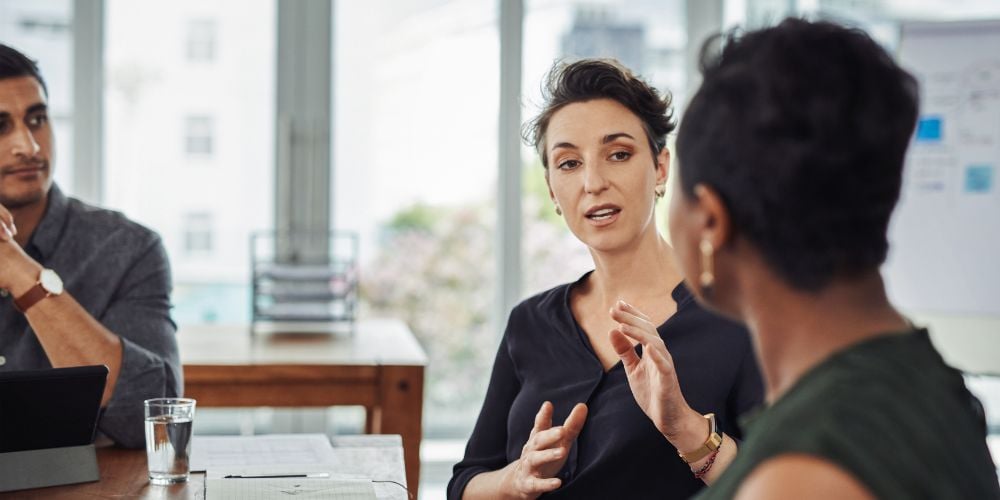5 Steps to Effective Communication in the Workplace
Does Each Meeting Have a Clear Agenda?
Building effective communication in the workplace is essential to creating happy, thriving work teams.
However, the sad truth is that many people have either said, or heard, the following:
“This could have been an email.”
“Why is he calling – can’t he just message me?”
“Can we take this offline?”
While there are instances when a meeting is most appropriate – one-on-ones, brainstorming, serious discussions – many hate the feeling of wasting an hour on a call when they could have been punching out a proposal.
Are Those Feedback-heavy, Hard Conversations Happening Face-to-face?
It’s easiest to fire off feedback, especially negative feedback, over email or instant message. However, that convenience comes at a cost. Without face-to-face communication, employees may overthink or misinterpret the conversation.
For example, do these sentences read differently in your mind?
Are you going to ask him about it? | Are you going to ask him about it???
Hey Annie, will you handle this? Thanks! | Annie, please handle this. Thanks.
Some may interpret ending a sentence with an exclamation point to be friendly and enthusiastic, while others may find it unprofessional and excessive, or even angry. On the flip side, some feel that ending sentences with periods is unfriendly and too formal, while others have been doing so their entire careers and feel it is polite.
Having a quick video or in-person conversation is a simple way to eliminate much confusion and add clarity to important discussions.

Are Managers Promoting a Mutual Feedback Environment?
According to a study by Bambee, 60% of participants reported feeling intimidated to go to a manager with an issue they were having.
Another study by Paychex found that 54% of respondents feel uncomfortable talking to their managers and supervisors about mental health, and, sadly, 29% of them believe opening up may even cost them a promotion. If an employee cannot communicate feelings of burnout, that is likely to affect their productivity, mood, and in the worst case, can lead to resignation or termination… all of which are terrible, preventable outcomes.
And sadly, the problem is mutual. Harris Poll found that 69% of managers shared that they are often uncomfortable communicating with their employees.
It is impossible to have a healthy work environment when both parties cannot be open and honest about their work, stress levels, and opportunities for improvement.
One simple way to improve effective communication in the workplace which can be implemented quickly is to promote one-on-one meetings in which mutual feedback is encouraged. In the beginning, it may be awkward, especially for the employee to provide feedback to their manager. However, both parties are fighting for the same goal: an improvement in work quality, morale, and retention. Those hard conversations will pay off.
Is Everyone Clear on the Company and Team Goals?
The shocking truth is that over 80% of small business owners don’t keep track of business goals (Staples National Small Business Survey). If the owners don’t have goals, how are any of their employees able to know if their efforts are successful, and how to tweak their processes if they're not?
It can be very demotivating for an employee to lack understanding when it comes to the effects of their work output, in both negative or positive situations.
It is crucial for successful, efficient businesses to take the time to look at analytics and create KPIs that employees can regularly check to measure their success. With goals in place, everyone is accountable, has a purpose, and there is nothing better than when the entire company can celebrate big wins at the end of the quarter.

Do Employees Have Clear “Focus Time” to Work Without Interruption?
Nothing grinds the gears of a busy, stressed employee than when their coworker keeps trying to chat about their weekend. While it is important and healthy to build rapport with colleagues, there are times when uninterrupted quiet time is necessary. When thinking about how to communicate effectively in the workplace, we suggest blocking off a few meeting-free hours per week in which employees can close Slack or Teams, not respond to emails, and be able to focus on their work. At KCare, we have implemented full focus days, as well as blocks of a few hours, and the results have spoken for themselves.
Effective communication in the workplace does not always feel intuitive, but there are simple ways to improve communication at work. It may require adjusting, but over time, your organization will likely find an increase in employee satisfaction, which leads to higher productivity and retention rate… all of which will greatly please everyone from the newbies to the executive board.
About KCare
KCare is a suite of innovative software solutions designed for behavioral health and human services organizations. Our industry-leading EHR, case management, and analytics products are designed to boost employee efficiency while improving client outcomes. For over 25 years, providers have trusted KCare to transform how they deliver care through our software solutions, including extendedReach, Exym, and Stabilify.
As a certified B Corporation, we operate our business in accordance with the highest standards of verified social and environmental performance, public transparency, and legal accountability. We are also part of the global Pledge 1% movement, donating 1% of our profits to the communities served by our customers.

 By
By



